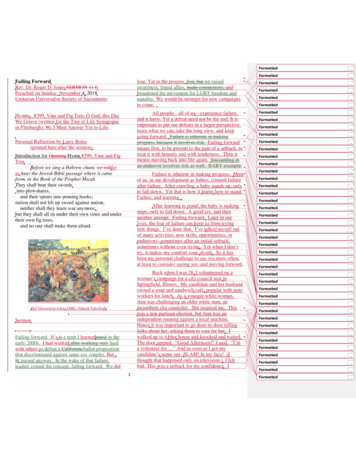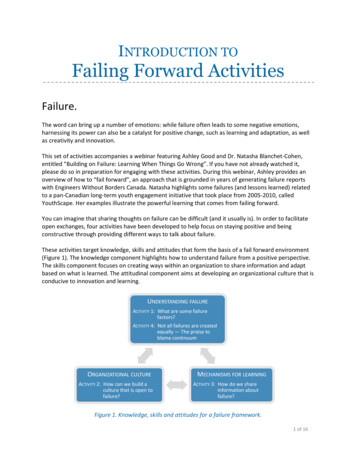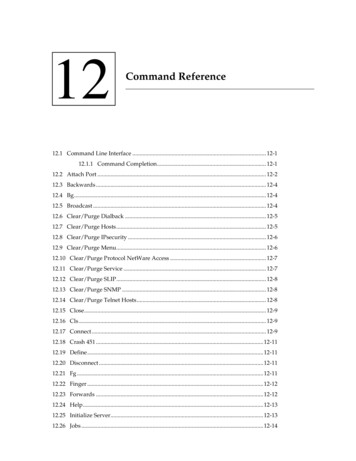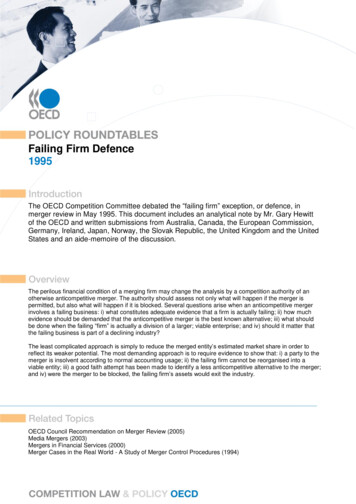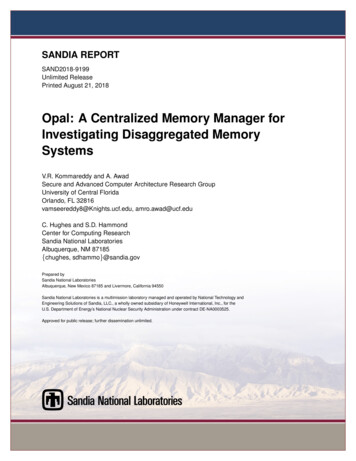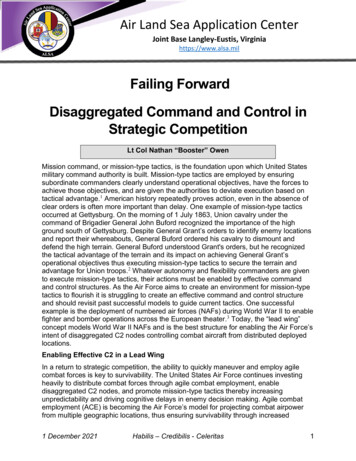
Transcription
Air Land Sea Application CenterJoint Base Langley-Eustis, Virginiahttps://www.alsa.milJoint Base lsa.milDisaggregated Command and Control inStrategic CompetitionLt Col Nathan “Booster” OwenMission command, or mission-type tactics, is the foundation upon which United Statesmilitary command authority is built. Mission-type tactics are employed by ensuringsubordinate commanders clearly understand operational objectives, have the forces toachieve those objectives, and are given the authorities to deviate execution based ontactical advantage.1 American history repeatedly proves action, even in the absence ofclear orders is often more important than delay. One example of mission-type tacticsoccurred at Gettysburg. On the morning of 1 July 1863, Union cavalry under thecommand of Brigadier General John Buford recognized the importance of the highground south of Gettysburg. Despite General Grant’s orders to identify enemy locationsand report their whereabouts, General Buford ordered his cavalry to dismount anddefend the high terrain. General Buford understood Grant's orders, but he recognizedthe tactical advantage of the terrain and its impact on achieving General Grant’soperational objectives thus executing mission-type tactics to secure the terrain andadvantage for Union troops.2 Whatever autonomy and flexibility commanders are givento execute mission-type tactics, their actions must be enabled by effective commandand control structures. As the Air Force aims to create an environment for mission-typetactics to flourish it is struggling to create an effective command and control structureand should revisit past successful models to guide current tactics. One successfulexample is the deployment of numbered air forces (NAFs) during World War II to enablefighter and bomber operations across the European theater.3 Today, the “lead wing”concept models World War II NAFs and is the best structure for enabling the Air Force’sintent of disaggregated C2 nodes controlling combat aircraft from distributed deployedlocations.Enabling Effective C2 in a Lead WingIn a return to strategic competition, the ability to quickly maneuver and employ agilecombat forces is key to survivability. The United States Air Force continues investingheavily to distribute combat forces through agile combat employment, enabledisaggregated C2 nodes, and promote mission-type tactics thereby increasingunpredictability and driving cognitive delays in enemy decision making. Agile combatemployment (ACE) is becoming the Air Force’s model for projecting combat airpowerfrom multiple geographic locations, thus ensuring survivability through increased1 December 2021Habilis – Credibilis - Celeritas1
targeting dilemmas.4 The new lead wing deployment model attempts to empowertactical leadership to execute mission-type tactics through the delegation of bothcommand and control authorities.5 This method enables agility and the continuousemployment of combat airpower even if lacking specific orders published through the airtasking order (ATO). Currently, the Air Force has given lead wing commanders authorityto conduct mission-type tactics, but these authorities have yet to be met with upgradedC2 capabilities nor the Airmen to effectively C2 lead wing assets in combat operations.Starting in World War II, the lead maneuver unit of the Air Force became the NAF, andNAF commanders conducted C2 of forces through assigned air operations centers(AOCs). However, AOCs now reside at the Major Command level effectively removingthe primary C2 structure from both the NAF and lead wings. It is time for the Air Force toinvest both dollars and manpower into rebuilding effective C2 capabilities within leadwings and across distant areas of responsibility (AORs).In a bid to rectify a lack of C2 capabilities in lead wings, the Air Force continues toinvest heavily in replacing the Theater Battle Management Core System as the legacysoftware for producing the ATO and airspace control order (ACO). The upgradedsoftware is application-based and meant to be easily accessible which enablescontinuity of operations by identifying fallback AOCs in the event of crippling cyberspaceor kinetic attacks.6 Investments in cloud computing are meant to enable continuousbackup and accessibility of the most current air operations information. Cloudcomputing enables fallback AOCs, or lead wings to immediately begin controllingcurrent air operations with minimal delay.7 Additionally, the Air Force is investing inconnecting worldwide sensors in all domains to the Advanced Battle ManagementSystem. This system is meant to collect, filter, and distribute information acrossnetwork-enabled units to provide a more accurate common operating picture tocommanders at all echelons of warfare.8 If successful, this cloud-based networkprovides the framework for distributed C2 operations and gives lead wing commandersthe technology to manage current ATO operations when necessary. Althoughinnovative, a new software solution only solves part of the issue. Lead wings still lackthe expertise and manpower needed to control aircraft across vast distances whilecontinuing to generate combat airpower. The Air Force has a readily available pool ofexperts in its current air support operations center (ASOC) and tactical air control party(TACP) Airmen. These Airmen are extensively trained in integrating joint firepower,controlling tactical aircraft, and enabling joint network connectivity who could quickly betrained to enable disaggregated control of lead wing aircraft using innovative softwaresolutions. These Airmen could direct aircraft to and from appropriate logistical hubs,pass updated intelligence via digital networks, control strikes in defense of friendlybases, and act as a bridge between other Service’s maneuver units and lead wingoperational planners.Realigning TACP in Support of Lead Wing OperationsAs the Air Force realigns resources against national security objectives, the TACPcommunity is facing extensive changes. Current TACP manpower grew during surgeoperations in Iraq and Afghanistan, and as the United States shifts focus away fromthose nations and towards pacing threats the TACP community finds itself overmanned.As the TACP community searches for mission relevancy against near-peer enemies, it2
has tried to reimagine TACP Airmen as all-domain controllers and has begun pushing anew concept called all-domain control teams. The introduction of all-domain controlteams as highly mobile C2 teams with the authority to enable effects across all domainsof warfare was meant to support the Air Force’s vision of disaggregated C2 nodes. Theintent is to enable teams of less than 10 personnel, from multiple services and careerfields to “command and control functions including defending bases, guiding aircampaigns, coordinating humanitarian assistance, or providing support for the U.S.Army. Dozens of these teams, operating in redundant networks, could provide asurvivable means of command and control against adversaries with sophisticatedtargeting capabilities”.9 A joint terminal attack controller (JTAC) from the 13 Air SupportOperations Squadron described this as allowing the AOC to “fail forward” and enablingall-domain control teams to continue executing the ATO until AOC operations resume.10Although novel in concept, the best location for all-domain control teams is with leadwing headquarters where the domain expertise can be integrated with operationalplanners to better enable effective C2 of current ATO operations. Integrating all-domaincontrol teams with lead wing agencies ensures joint tenets of effective C2 are met whileenabling mission-type tactics by preserving unity of command and enabling the AOC tofail forward when needed.Airmen work in the 618th Air and Space Operations Center (Tanker Airlift Control Center) controllingglobal mobility operations at Scott Air Force Base, Ill. Dec. 16, 2010. (Photo by: Capt. Justin Brockhoff,USAF)3
Joint Tenets of Effective Command and ControlCurrent doctrine defines ten tenets to effective command and control. As strategiccompetition drives the need for innovation, it is important to link advancements intechnology with proven doctrine or risk repeating hard lessons learned. It is vital newcommand and control systems adhere to the joint tenets of command and control asdisaggregation and decentralization risk adding complexity and uncertainty to analready congested C2 environment. Although joint doctrine identifies ten tenets toeffective C2, those of mutual trust, information management and knowledge sharing,simplicity, and situational awareness are most at risk by disaggregated C2.11 Isolatedteams, distributed across the battlespace, and reliant on satellite or radiocommunication to maintain situational awareness introduce enormous risks to thetenets of effective command and control.12Agile combat employment doctrine assumes that combat aircraft will effectivelyconverge at a designated time and place to mass firepower in pursuit of operationalobjectives. To achieve this convergence, the Air Force participates in large-scaleexercises such as Red Flag. In fact, large-scale combat exercises are used to qualifycombat mission commanders, who are given authorities from the combined forces aircomponent commander (CFACC) to make real-time decisions during ATO execution.Flying mission commanders are only delegated authorities after establishing mutualtrust and demonstrating tactical competency. In addition to developing missioncommanders capable of leading joint air operations, the Air Force also aligns airoperations support units with Army maneuver units. The two Services train together,deploy together, and often live on the same installation with the purpose of buildingrelationships and establishing mutual trust to enable the integration of air and groundfires in support of Army maneuver. Mutual trust is a joint tenet of C2, and establishingmutual trust allows units to work cohesively based on expected behaviors developedduring routine day-to-day activities and joint training exercises.13 Although the hightempo of counterinsurgency deployments has broken alignment, current TACPleadership argues new technologies reduce this risk to acceptable levels and arepushing to break alignment of TACP and Army forces permanently. One paper suggeststhe past alignment model is no longer needed because upgrades in technologies betterenable beyond-line-of-sight communications, allow for effective collaboration with otherServices, and enable the timely distribution of information to allow a common operatingpicture across the entire area of operations.14 Network-enabled communications havegrown tremendously, but the lack of aligned forces will quickly lead to a breakdown inmutual trust across the joint force and negatively affect joint C2 of forces. Airmenassigned to support Army maneuver units must remain aligned with the supported unit.As such, airmen assigned to support lead wing C2 should be assigned full time to thesupported wing. Mutual trust built from enduring relationships and joint exercises is thebest method to ensure integrated joint operations as the Air Force moves towards leadwing operations and disaggregated C2 networks.The distribution of assets and C2 structures across the AOR enables survivability, but italso complicates the ability to share and manage information. Information managementand sharing is a key tenet of command and control which enables enhanced situationalawareness.15 The current theater air-ground system (TAGS) demonstrates risks4
associated with poorly networked command and control structures. The Air Force’sTBMCS still produces the ATO and ACO using United States Messaging Text Format(USMTF) 2004. These messages are digitally used by numerous joint fires systems toinclude the Joint Automated Deep Operations Coordination System, the Advanced FieldArtillery Tactical Data System, and the Tactical Airspace Integration System.16 However,each of these systems operates with different versions of USMTF, and therefore,humans must be present to translate messages and ensure the systems execute theintended operation. The inability of joint fires C2 systems to connect and shareinformation degrades situational awareness at each level of command. In adisaggregated C2 structure, the ability to connect with multiple C2 systems across thejoint force is vital to building effective situational awareness. Situational awareness isthe linchpin to delegating mission command authority to lower echelons. Acommander’s ability to develop an accurate common operating picture enables effectivedecision making and mission-type tactics. A lead wing structure, embedded withpersonnel from all domain control teams enables the effective building of a commonoperating picture necessary to delegate, or accept mission command authorities.U.S. service members participating in the first VIRTUAL FLAG exercise dedicated to training the Joint AirGround Integration Center’s (JAGIC) command and control work in the the 705th Combat TrainingSquadron’s Distributed Mission Operation Center, Kirtland Air Force Base, New Mexico, Aug. 23-27,2021. (Photo by: Debora Henley, USAF)5
Simplicity is perhaps the tenet most at risk with disaggregated command and controlnodes, and the deployment of all-domain control teams creates a burdensome layer ofcontrol when the Air Force already has established AOCs, lead wings, ASOCs, JTACs,and airborne mission commanders. Currently, joint command and control is achievedthrough Service-centric units connected to sister Services by digital networks andliaison units. The AOC has an Army battlefield coordination detachment, along withNavy, Marine, special forces, and Space Force liaisons to help plan and execute airoperations.17 Each Service’s operational and tactical C2 structures rely on liaisonorganizations to bring Service-specific expertise to planning and execution processes.These liaisons effectively enable pathways across the Service-specific lanes of C2.Simplicity means limiting the number of C2 units to those necessary for maintainingpositive control over deployed forces. Adding an additional C2 structure through alldomain control teams creates an unnecessary layer of control on air assets operatingwithin CFACC airspace, which do not require detailed integration with friendly forces.Therefore, publishing clear authorities for lead wing commanders and airborne missioncommanders through rules of engagements (ROE) enables disaggregated C2 withoutthe addition of new controlling agencies. These ROEs enable lead wing commanders tomake tactical decisions focused on the commander’s intent while bounded by theauthorities placed upon him or her. Additionally, the designated mission type brings withit specific authorities defined through doctrine. For example, close air support missionsrequire detailed integration with ground force commanders and require the control ofassets by joint terminal attack controllers. Whereas the designation as a strikecoordination and reconnaissance (SCAR) mission tells the pilot he or she must checkinto the AOR with the SCAR mission commander and guides which authorities theaircrew possess. The effective delegation of authorities allows the above controllingorganizations to execute mission-type tactics, achieving the Air Force’s desired endstate.ConclusionTo best empower lead wings to effectively C2 distributed forces, additional C2 Airmenand networks should be assigned to the lead wing deployment team. The lead wingfulfills the disaggregation of C2 networks and allows for the AOC to fail forward whilehonoring the joint tenets of C2. The integration of surplus air support operations units asall domain control teams within the lead wing structure provides the manpower neededto enable effective C2 of forces. Instead of trying to build small, mobile all-domaincontrol teams, the Air Force should focus on enabling mission command and promotingmission-type tactics of distributed combat forces through well-equipped and trained leadwings. With these integrators embedded in operational staffs, lead wing commandersgain valuable knowledge on joint C2 systems, service-specific weapons systems, andthe best methods to integrate effects across the joint force and within all domains. Thequestion now becomes, in the face of peer adversaries and the return to strategiccompetition how does the Air Force better employ TACP Airmen? Does the Air Forceuse TACP Airmen as traditional controllers of air assets, or does the Air Force capitalizeon years of joint integration experience to develop integration experts built to enablelead wing operations integrated within the joint area of operations?6
Endnotes1Joint Publication 1, Doctrine of the Armed Forces of the United States. 25 March 2013, V-15.Wittenberg, Eric J. The Devil’s to Pay: John Buford at Gettysburg. 19 October 2014.3Air Force Combat Units of World War II. United States Air Force Historical Advisory Committee, 1 Sept 1983.4Mulgund, Sandeep PhD. Command and Control for Agile Combat Employment. Online Air University, 30 August2021.5Leslie, Carlin. Agile Flag paves way for Lead Wings. Online Air Force News, 3 November 2020.6Volpe, Carrie. 609th AOC optimizes ATO production, first to use KRADOS operationally. Online Air Force News, 7May 2021.7Coleman, Frederick. Beyond the AOC-Building the Next Generation of Operational Command and Control. OnlineAir University, 28 October 2021.8Pope, Charles. With its promise and performance confirmed, ABMS moves to a new phase. Online Air Force News,21 May 2021.9Cowie, Command and Control, 2 July 2021.10Bold Quest 2021 discussion on all domain command and control tactics.11Joint Publication 1, Doctrine. V-14-17.12Coleman. Beyond the AOC. 28 October 202113Joint Publication 1, Doctrine. V-17.14Cowie, Command and Control, 2 July 2021.15Joint Publication 1, Doctrine. V-15.16ATP 3-52.1/MCRP 3-20F.4/NTTP 3-56.4/AFTTP 3-2.76, Multi-Service Tactics, Techniques, and Procedures forAirspace Control. Air Land Sea Application Center, February 2019.17ATP 3-52.2/MCRP 3-20.1/NTTP 3-56.2/AFTTP 3-2.17, Multi-Service Tactics, Techniques, and Procedures for theTheater Air-Ground System. Air Land Sea Application Center, May 2020.27
Failing Forward Disaggregated Command and Control in Strategic Competition Lt Col Nathan "Booster" Owen Mission command, or mission-type tactics, is the foundation upon which United States . Operations Squadron described this as allowing the AOC to "fail forward" and enabling all-domain control teams to continue executing the ATO .
